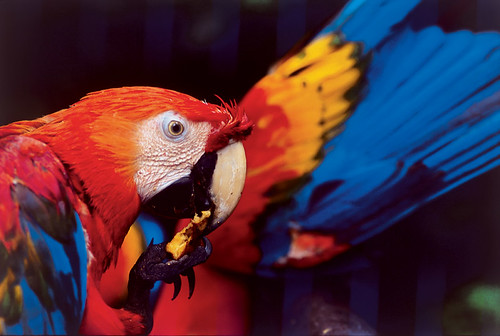
Taking photos is an essential part of the travel experience, and animals are often the main attraction when it comes to ecotourism. Many times, the most memorable moments of a vacation involve seeing exotic wildlife in their natural habitat – whether it's monkeys swinging through the trees above your rainforest bungalow, dolphins leaping out of the ocean, or a magnificently plumed tropical bird landing on a nearby branch. For me, it was watching a sea turtle glide serenely by while scuba diving off the coast of Roatán, Honduras. As he plucked a morsel of food from a coral reef, paying me no mind, I was keenly aware of how lucky I was to be a guest in his home.
As you appreciate the wildlife you encounter on your next trip, it's important to be conscientious of your impact on their behavior and habitat. Animals are notoriously difficult subjects to shoot, especially for the average traveler with a simple point-and-shoot camera. Unfortunately, that leads some tourists to engage in practices that can be harmful and disruptive to wildlife and/or their habitats. Here are some easy tips for taking fabulous AND responsible wildlife photos!
1) NEVER feed wild animals
It may seem like an easy solution to lure animals with food so that you can get a closer photo. However, feeding wild animals is a very harmful practice that interferes with their natural behavior and upsets the balance of their diet and lifestyle. Eating human food that is not normally a part of their diet can cause serious health problems. In addition, if they become used to receiving food from humans, it diminishes their natural skills for procuring food for themselves, and can also make them behave aggressively towards humans they see later. Sometimes animals will migrate to human-populated areas in search of an easy meal, where they become a nuisance to local people and are killed intentionally or accidentally, by cars, power lines, and other hazards. Reproductive rates can also spike when an artificial food source is available, which leads to a larger animal population than the area can naturally support. These are just a few of the reasons why you should never, ever feed wildlife.
2) Invest in extra memory storage
Animals are unpredictable, and you won't know how each photo really turned out until you look through them all later on a bigger screen than your camera's little LCD. Take way more photos than you think you need, especially if they're moving around – you'll have more luck capturing the instant they strike the perfect pose or the light hits them in the just right way. Invest in a memory card to expand your camera's storage capabilities so you don't have to worry about running out of memory while you're on a photo safari. A 16 GB memory card costs about $10 and will hold about 2,500 photos (on a 12 megapixel camera).
3) Get both close-ups and wide shots
Both close-ups and wide shots make for very interesting wildlife photos. For example, look at these two very different bird photos:
 |
 |
Close-ups show the animal's personality and the texture of their fur, scales, feathers, etc. If it's not safe or plausible to get very close, which is usually the case with larger animals, use your zoom. Wide shots show context, movement, and the animal's beautiful habitat. So much cooler than photos taken at the zoo!
4) Know when to go
Seasonal changes can affect when animals will be the most abundant, especially with migratory species such as sea turtles, whales, and certain birds. Do your research beforehand – find out which season your target animal will be in the area you are visiting. Remember to learn about the animal's daily behavior as well. Some animals only emerge from their hiding place at the crack of dawn, while others are most active at dusk or nighttime. Local people such as hotel staff or tour guides will be the best resource for this kind of information.
5) Don't forget the little guys
The most popular animals for ecotourists are usually the big, charismatic mammals like monkeys, colorful birds, and whales. However, some of the most beautiful and interesting photos are of the little guys we don't usually notice, such as insects and frogs. A magnificent photo just might be crawling about underfoot, so don't forget to crouch down and catch the world from a "smaller" perspective!

Did we miss any wildlife photography tips that have helped you on your past vacations? Leave a comment and let us know!


